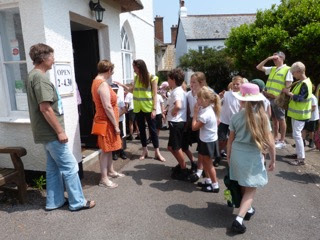'Budleigh rocks' say local schoolchildren

Two groups of children from Budleigh’s St Peter’s C of E Primary School learnt at first hand about the area’s unique geology from experts at Fairlynch Museum. On Wednesday 8 June, Sycamore Class and Cedar Class explored fossils and rocks with the Museum’s Head of Geology and Environment Nicky Hewitt and Kate Somerby, Fairlynch Trustee and Arts Education Specialist.
The two museum volunteers are seen, left, in the above photo as they greeted pupils and accompanying teachers.


The children were fascinated to learn about the collection’s oldest fossil, named after the town where it was discovered and known officially as Orthis budleighensis. They learnt how the fossil, a rare brachiopod similar to a mollusc and at least 445 million years old, had come out of a pebble on Budleigh beach.

The children were shown the different strata in the mountains which formed the local landscape millions of years ago and were intrigued by the different colours reflected in the pebbles, particularly seen in the quartz layers.
The celebrated nodules written about by Nobel Prize-winning scientist Max Perutz were also one of the talking-points of the visit. The children learnt about the different minerals present in rocks.
After Fairlynch, the classes visited two other locations on Budleigh beach to discover more about our unique geography and geology.
‘This visit supported their Science learning during the final half term,’ said a school spokesperson. ‘Our engagement with community partners and the local environment are key features of the unique St Peter's Curriculum.’





Comments
Post a Comment